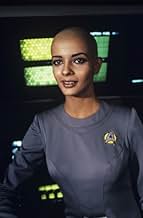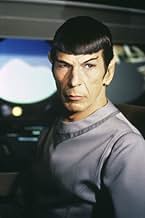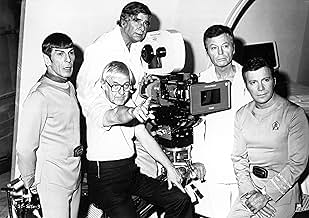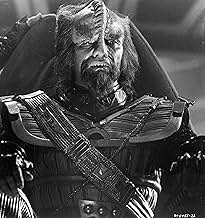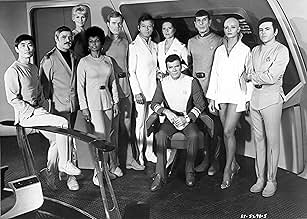El almirante James T. Kirk retoma el mando del USS Enterprise para interceptar una nave extraterrestre de enorme poder cercana a la Tierra.El almirante James T. Kirk retoma el mando del USS Enterprise para interceptar una nave extraterrestre de enorme poder cercana a la Tierra.El almirante James T. Kirk retoma el mando del USS Enterprise para interceptar una nave extraterrestre de enorme poder cercana a la Tierra.
- Nominado para 3 premios Óscar
- 4 premios y 21 nominaciones en total
John Gowans
- Assistant to Rand
- (as John D. Gowans)
Argumento
¿Sabías que...?
- CuriosidadesWhen Captain Kirk addresses the crew before launching, many of the extras were noted Star Trek fans, including Bjo Trimble, co-organizer of the letter-writing campaign that kept Star Trek: La serie original (1966) alive for a third season.
- PifiasWhen flying past Jupiter, three consecutive shots of Jupiter and its moons are shown. The first and third are from the POV of the ship as it approaches and passes Jupiter, and show the sunshine on planet and several moons coming from the port aft. The second shot shows the opposite angle of the oncoming ship, and the sunshine on the planet and 4 moons is coming from a different direction on each body, none of them from the port aft.
- Créditos adicionalesEnd title: "The human adventure is just beginning."
- Versiones alternativasOn November 6, 2001, the Director's Edition supervised by Robert Wise was released on DVD and widescreen VHS, running 136 minutes. The material added to the film consists of the following:
- The landscape of Vulcan was changed to include a yellowish sky and new landscape featuring massive statues. All other footage was tinted gold.
- The matte painting of the Golden Gate Bridge in the scene where Kirk arrives at Starfleet Headquarters was replaced by a new CGI scene that shows Kirk's shuttle arriving at Starfleet. It is actually slightly longer than the original version.
- The matte painting of Starfleet Command was improved with CGI effects, including an original series shuttle launched in the background.
- In a close-up shot when Kirk first sees the new Enterprise from his shuttle, the image of the ship was superimposed over Kirk's face as a reflection in the shuttle's window.
- After Kirk leaves the bridge, a short conversation between Sulu, Uhura and an alien officer was inserted.**
- A new CGI shot of the Earth is shown on the viewscreen when the Enterprise leaves the planet.
- A new CGI effect showing one of the Enterprise's nacelles was inserted into the window when Kirk, Spock and McCoy speak on the observation deck.
- A new CGI shot was inserted which shows V'Ger's second energy torpedo vanishing before it could strike the Enterprise.
- The energy probe that invades the bridge now approaches in a CGI exterior shot.
- A new CGI shot shows the V'Ger vessel entering Earth orbit.
- The scene in which Chekov burns his hand is much longer and shows Lt. Ilia healing him with her empathic powers instead of Nurse Chapel.**
- The long walk to V'Ger was totally redone. There is now a walkway that materializes out of thin air, compared to the endless field in the original version.
- The Enterprise's voyage to the center of V'Ger is slightly extended. It has a scene of Spock sharing a tear "for V'Ger" and Scotty ordered to self-destruct the ship if the landing party is unsuccessful.**
- The small black "empty matte" in the window when Decker and Ilia confront each other in the recreation deck was replaced with a CGI shot of the V'Ger cloud interior.
- The final explosion of V'Ger was slightly extended. The shot from the original version remained intact, but a new element of the vessel imploding its energy for the explosion was added.
- New opening titles were commissioned for the film's opening. The opening titles now have a slight fading effect and are now seen over a background of stars. The text is colored a bright gold, compared to the original version's white.
- The explosion in the wormhole was redone. There is now an exterior shot of the asteroid exploding and the wormhole disintegrating. Additionally, the viewfinder in the next shot is enhanced to show sparks and debris.
- The final message to the audience, "The human adventure is just beginning", was altered. In the original version, the starfield cuts away to a blank title card showing the text. In the Director's Edition, the starfield was extended by a few seconds to allow the text, colored bright gold, to fade into the picture.
- The ending credits were slightly altered. The text, as with the opening titles and the final "human adventure" text, was changed color, from white to a bright gold. Additionally, the music was slightly extended to add new Director's Edition credits.
- An all-new sound mix was commissioned, keeping the music and dialog intact, and adding new effects for almost all scenes. For example, the Enterprise computer voice alarms are now replaced with klaxon sirens, the lightning effects have new echoes, and a blend of Enterprise bridge sound effects from the original Star Trek series, Star Trek II: The Wrath of Khan, and Star Trek VI: The Undiscovered Country have been added into the background of scenes taking place on the bridge. The new mix is in Dolby 5.1 EX Surround.
- The footage from 1979 was digitally restored and remastered, and combined with the new CGI elements.
- The opening overture has been restored to its full length. It is also played over a CGI starfield, rather than the blank screen in the original version.
- A slight dialog alteration was made: In the 1979 and 1983 versions, the V'Ger cloud is said to be "over 82 AUs in diameter" which equals 7.626 billion miles across - much too large for the Enterprise to realistically travel to the heart of the cloud at subwarp speeds within a reasonable length of time. For the Director's Edition, the Epsilon 9 commander's dialog was altered so that the cloud is now said to be a (somewhat) more reasonable "over 2 AUs", or 186 million miles.
- The producers of the Director's Edition submitted the film for re-rating by the MPAA, hoping for a PG rating rather than the original G rating which they believed carried a negative association; the basis for the higher rating was the intensified soundtrack. Oddly, when the original theatrical version was released on DVD and Blu-ray in 2009, it carried no MPAA rating.
- Scenes previously available in the "special longer version."
- ConexionesEdited into Star Trek II: La ira de Khan (1982)
- Banda sonoraTheme from 'Star Trek: The television Series'
Written by Alexander Courage and Gene Roddenberry
Reseña destacada
Star Trek: The Motion Picture has its unique place in cinema history as probably the first television series to get a big screen motion picture. Completely due to its special fan base, the like of which has never been seen before or since.
In order to keep the phenomenon going Gene Roddenberry knew he had to have something special to offer and he did. The continuity from the television series was accomplished effortlessly, in fact one of the new characters Commander William Decker is the son of William Windom who was another starship captain in an episode. More I can't say less I give the plot away.
In fact Decker played by Stephen Collins would be commanding the newly fitted Enterprise if it were on a routine mission. But with the threat of an immense alien being on a direct path to earth now Admiral James T. Kirk takes command of the starship himself and with Decker reunites all the old crew from the TV series to meet the threat.
Fans of the original series will also see the similarities in plot between another episode involving the Enterprise meeting up with an old space probe that now has taken on some new functions. The same idea forms the basis of this film's story although in every way it has been expanded and a new ending conceived. Here's a hint, a budding relationship between Collins and new ship's lieutenant Persis Khambatta is what ultimately saves the earth.
Just as you remember them William Shatner, DeForest Kelley, Leonard Nimoy, James Doohan, Nichelle Nichols, George Takei, and Walter Koenig are all back and completely in character as you remember them. The new people Collins, Khambatta and the rest are integrated nicely into the story.
Star Trek: The Motion Picture received three Academy Award nominations, for Best Art&Set Direction, Best Visual Effects, and Best Musical Score. The special effects never overwhelm the telling of a good story which is the primary mission and best asset of the original television series and its successors.
If you're not a Trekkie before seeing this film, you may be come one upon viewing.
In order to keep the phenomenon going Gene Roddenberry knew he had to have something special to offer and he did. The continuity from the television series was accomplished effortlessly, in fact one of the new characters Commander William Decker is the son of William Windom who was another starship captain in an episode. More I can't say less I give the plot away.
In fact Decker played by Stephen Collins would be commanding the newly fitted Enterprise if it were on a routine mission. But with the threat of an immense alien being on a direct path to earth now Admiral James T. Kirk takes command of the starship himself and with Decker reunites all the old crew from the TV series to meet the threat.
Fans of the original series will also see the similarities in plot between another episode involving the Enterprise meeting up with an old space probe that now has taken on some new functions. The same idea forms the basis of this film's story although in every way it has been expanded and a new ending conceived. Here's a hint, a budding relationship between Collins and new ship's lieutenant Persis Khambatta is what ultimately saves the earth.
Just as you remember them William Shatner, DeForest Kelley, Leonard Nimoy, James Doohan, Nichelle Nichols, George Takei, and Walter Koenig are all back and completely in character as you remember them. The new people Collins, Khambatta and the rest are integrated nicely into the story.
Star Trek: The Motion Picture received three Academy Award nominations, for Best Art&Set Direction, Best Visual Effects, and Best Musical Score. The special effects never overwhelm the telling of a good story which is the primary mission and best asset of the original television series and its successors.
If you're not a Trekkie before seeing this film, you may be come one upon viewing.
- bkoganbing
- 28 dic 2010
- Enlace permanente
Selecciones populares
Inicia sesión para calificar y añadir a tu lista para recibir recomendaciones personalizadas
Detalles
- Fecha de lanzamiento
- País de origen
- Sitio oficial
- Idiomas
- Títulos en diferentes países
- Viaje a las estrellas
- Localizaciones del rodaje
- Yellowstone National Park, Wyoming, Estados Unidos(portions of planet Vulcan sequence filmed at Minerva Terrace)
- Empresas productoras
- Ver más compañías en los créditos en IMDbPro
Taquilla
- Presupuesto
- 35.000.000 US$ (estimación)
- Recaudación en Estados Unidos y Canadá
- 82.604.699 US$
- Fin de semana de estreno en EE. UU. y Canadá
- 11.926.421 US$
- 9 dic 1979
- Recaudación en todo el mundo
- 82.676.805 US$
- Duración2 horas 23 minutos
- Color
- Mezcla de sonido
- Relación de aspecto
- 2.39 : 1
Contribuir a esta página
Sugerir un cambio o añadir el contenido que falta

Principal laguna de datos
By what name was Star Trek: La película (1979) officially released in India in Hindi?
Responde



